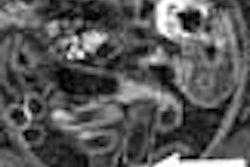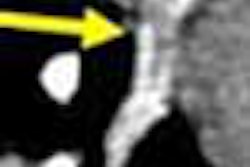When clinicians order CT pulmonary angiography to rule out suspected pulmonary embolism, are they using it as an all-purpose cardiovascular screening test?
The loaded question defies easy answers, of course, as do others such as "When does the potential harm in scanning outweigh the potential benefits?" or even "Why fault an abundance of caution on the part of clinicians faced with acute PE, a serious condition that strikes a half-million people a year in the U.S. alone, killing more than 15% of them within three months?"
But rather than taking the armchair view of a trend toward more CTPA combined with fewer positive findings, physicians from the University Hospitals of Cleveland and Case Western Reserve University School of Medicine in Cleveland believe it's time for researchers to address the appropriate use of CTPA.
Specifically, they say, it's time to ask which indications make the exam appropriate, and which patients are likely to benefit rather than suffer from the treatment of positive findings, especially the small, subsegmental emboli that newer MDCT scanners are detecting more of.
Their study, in the October issue of American Journal of Roentgenology, quantifies what many radiologists have noticed on their own: Clinicians are ordering more CTPA exams, while the positivity rate is falling dramatically.
"With the advent of helical CT and its subsequent technological improvements, clinicians acquired a powerful noninvasive tool for the evaluation of patients with suspected pulmonary embolism," wrote Drs. J. David Prologo, Robert Gilkeson, Mireya Diaz, and Joe Assad (American Journal of Roentgenology, October 2004, Vol. 183:4, pp. 1093-1096).
"This combination of technical improvement, diagnostic accuracy, and excellent patient outcomes has resulted in .... a significant increase in the use of CT pulmonary angiography," they wrote. "The large number of scans being obtained on newer MDCT scanners is likely to continue to result in an increased number of small subsegmental emboli being detected....Will the findings in each of these patients warrant the well-documented risk of anticoagulation treatment?"
Their study sought to compare a hospital's use of CTPA during two nine-month intervals, in 1997-1998 and 2002-2003. In all, 1,064 patients were examined, including 850 in 2002-2003 using either single-slice CT (n = 34) or MDCT (n = 816). The 214 patients scanned in 1997 all underwent single-slice scanning.
A bolus of 90-120 mL of contrast material was administered intravenously to all patients. CT scanning occurred in a cephalocaudal direction during a single breath-hold from the thoracic inlet through the domes of the diaphragms, the authors wrote. Single-slice CT (PQ5000, Philips Medical Systems, Bothell, WA) was performed using 3-mm collimation, pitch 1.7, 120 kVp, 250 mAs. Multidetector-row CT images were acquired on a Philips MX8000 IDT scanner using 2-mm collimation, pitch 1, 120 kVp, 250 mAs.
Radiologists examined the data for the presence of pulmonary artery filling defects and the presence of ancillary findings. All the images were interpreted on workstations, using multiplanar reconstructions, and lung and mediastinal window settings as needed.
In 2002-2003, a total of 850 patients were referred for CTPA, including 349 inpatients and 501 emergency department patients. In 1997-1998, only 219 patients underwent the exam, including 135 inpatients and 79 emergency department patients. Thus, the number of patients imaged was significantly greater (homogeneity of rates = 88.45, p < 0.0001), both among emergency department patients (x2 = 167.03, p < 0.0001) and inpatients (x2 = 210.62, p < 0.0001), in the later period.
"Patient demographics were similar between groups except that the group of 1997-1998 inpatients were somewhat older (Student's t test = 3.78, p < 0.01), and included a larger proportion of men (44.44% versus 34.00%, x2 = 4.47, p < 0.036) than its 2002-2003 counterpart," they wrote.
Also, while the use of V/Q scintigraphy and pulmonary angiography diminished over time, the absolute number of CT scans was significantly higher in 2002-2003, both in the emergency department (x2 = 167.03, p < 0.0001) and inpatient (x2 = 210.62, p < 0.0001) cohorts. The drop in pulmonary angiography use over time was especially pronounced among emergency department patients versus inpatients (homogeneity of odds = 0.003, p < 0.007).
Underscoring the impact of technological improvements in CT scanning, findings of isolated subsegmental emboli increased from 0 in 1997-1998 to 13 in 2002-3002. At the same time, the number of scans interpreted as normal increased significantly in the more recent period.
"Significantly fewer ancillary findings were reported in both the emergency department (x2 = 5.93, p < 0.0019) and inpatient (x2 = 6.03, p = 0.015) groups in the more recent population," the authors wrote. "The incidence of CT-detected pulmonary embolism was significantly less in both the emergency department (x2 = 34.26, p < 0.0001) and inpatient (x2 = 8.52, p < 0.01) groups in the more recent population."
The decrease in positive PE findings over time was far greater among emergency department patients than among inpatients (homogeneity of odds = 0.003, p < 0.0007), they added.
"The radiologic evaluation of pulmonary embolism has undergone considerable recent change," the authors wrote. "Historically, ventilation-perfusion scanning has been the imaging method of choice in patients with suspected pulmonary embolism." Early CT studies showing reported sensitivity and specificity approaching 100% for proximal emboli and 60% to 94% for distal clots helped cement its reputation as a diagnostically useful alternative.
At the same time, the trend toward increasing CT use, and increasing detection of subsegmental emboli seen with MDCT scanners and thinner collimation, raises important questions, the authors noted.
Specifically, researchers must address whether treating the small, subsegmental clots that the newer scanners are finding more of outweighs the known risks of anticoagulation therapy -- and whether the radiation dose associated with thin-section CT scans can be justified by patient outcomes, the authors wrote.
"In light of the increasing availability and acceptance of CT pulmonary angiography as a first-line imaging technique, these and other questions need to be addressed as investigators continue to define the precise role of CT in the workup of suspected acute pulmonary embolism," the authors concluded.
By Eric Barnes
AuntMinnie.com staff writer
October 11, 2004
Related Reading
CT for PE: Best test gets better, September 10, 2004
MDCT drives important changes in U.K. healthcare, August 10, 2004
Combined test strategy safely detects pulmonary embolism in outpatients, March 11. 2004
MDCT pulmonary angiogram rules out PE for months, March 22, 2004
Volumetric capnography points to pulmonary embolism, March 17, 2004
CT assessment of pulmonary embolus predicts prognosis, March 16, 2004
Troponin I test adds to prognostic value of echo in acute pulmonary embolism, October 27, 2003
Copyright © 2004 AuntMinnie.com



















